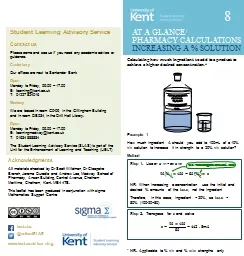

Example 1 How much ingredient A should you add to 100mL of a 10 vv solution to increase it in strength to a 20 vv solution Method AT A GLANCE PHARMACY CALCULATIONS INCREASING A SOLUTION ID: 776436
Download Presentation The PPT/PDF document " Calculating how much ingredient to add ..." is the property of its rightful owner. Permission is granted to download and print the materials on this web site for personal, non-commercial use only, and to display it on your personal computer provided you do not modify the materials and that you retain all copyright notices contained in the materials. By downloading content from our website, you accept the terms of this agreement.
Slide1
Calculating how much ingredient to add to a product to achieve a higher desired concentration.*
Example 1How much ingredient A should you add to 100mL of a 10% v/v solution to increase it in strength to a 20% v/v solution?Method
AT A GLANCE/
PHARMACY CALCULATIONSINCREASING A % SOLUTION
8
* NB:
Applicable to % v/v and % w/w strengths only
Step 1:
Use c1 x v1= c2 x v2NB: When increasing a concentration use the initial and desired % amounts of the base, not the ingredient Therefore, in this case, ingredient = 20%, so base = 80% (100-20=80)
Step 2:
Transpose for x and solve
percentages cancel out
Student Learning Advisory Service
Contact us
Please come and see us if you need any academic advice or guidance.
Canterbury
Our offices are next to Santander Bank
Open
Monday to Friday, 09.00 – 17.00
E: learning@kent.ac.uk T: 01227 824016MedwayWe are based in room G0-09, in the Gillingham Buildingand in room DB034, in the Drill Hall Library.OpenMonday to Friday, 09.00 – 17.00E: learningmedway@kent.ac.uk T: 01634 888884The Student Learning Advisory Service (SLAS) is part of theUnit for the Enhancement of Learning and Teaching (UELT)
www.kent.ac.uk/learning
kent.slas
@
unikentSLAS
Acknowledgments
All materials checked by Dr Scott Wildman, Dr Cleopatra Branch, Jerome Durodie and Andrew Lea, Medway School of
Pharmacy, Anson Building, Central Avenue, Chatham Maritime, Chatham, Kent. ME4 4TB.This leaflet has been produced in conjunction with sigma Mathematics Support Centre
Slide2Example 2What quantity of ingredient B should you add to 200mL of a 20% v/v solution to increase it in strength to a 50% v/v solution?Method
Q1How much ingredient D should you add to 400mL of a 5% v/v solution to increase its strength to a 20% v/v solution?Q2What quantity of ingredient D should you add to 1.2L of a 2.5% v/v solution to increase its strength to a 10% v/v solution?Q3You have 80g of a 15% concentration of ingredient E. What weight of ingredient E should you add to increase its strength to 20%?Q4How much of ingredient F will be required to increase the strength of 1.5L of a 1% v/v solution to a 10% solution?Q5What weight of ingredient G should be mixed with 2500mg of an 8% w/w concentration of ingredient G to increase it in strength to 20%?AnswersQ1 = 75mL. Q2 = 100mL. Q3 = 5g. Q4 = 150mL. Q5 = 375mg
Step 3: Subtract the total original volume from the new volume
Step 3:
Subtract the total original volume from the new volume
Example 3
What weight of ingredient C should you add to 120g of a 2% w/w concentration to increase it in strength to a 4% concentration?Method
Step 3: Subtract the total original volume from the new volume
Step 1:
Use c1 x v1= c2 x v2
Step 2:
Transpose for x and solve
Step 1:
Use c1 x v1= c2 x v2
Step 2:
Transpose for x and solve
percentages cancel out
percentages cancel out